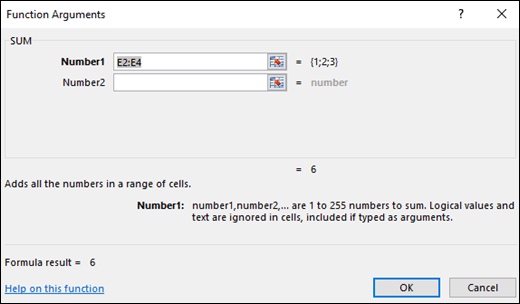Reminder: Please download the files that were given.
I would first strongly recommend reading this guide on Excel formulas. For each of the Date functions discussed below, read the reference guides from Microsoft and Google .
Getting Started
Every function has a unique name and purpose.
- For example, SUM() =/= SUMIF() =/= SUMIFS()
Functions usually take in specific inputs called "parameters" or "arguments". These parameters can be:
- numbers,
- text,
- dates,
- cell references,
- cell ranges,
- and even other formulas and functions!
This Microsoft article
can help explain more.
For example, understanding how the Function Dialog (fx) Box works as shown below can help:

This web page serves as a tutorial guide covering some common key functions you should know.
A) TODAY() Function |
Reference guideThe purpose of the TODAY() function is to return todays current date.
This function takes in no arguments (inputs) and it's syntax is as follows: =DATE()
This function will update automatically when the worksheet changes or opens.
Typically by default Excel workbooks are set to update Automatically.
This can be confimred by going to:
Formulas (tab) -> Calculation (group) -> Caluclation Options
The 'F9' key is a shortcut key used to manually recalculate the worksheet and update the value if it
doesn't update.
The user can also go to:
Formulas (tab) -> Calculation (group) -> Calculate Now (F9) to force
a manual update.
Since the output is a date, you can format the result in a different date number format if needed (e.g. YY-MM-DD, MM-YYYY, etc).
NOTE: To insert a fixed date and time that won't update, use these keyboard shortcuts:
Current date: Press Ctrl + ;
Current time: Press Ctrl + Shift + :
To see the date one week from today, use this formula:
= TODAY() + 7 // one week in the future
B) Weeknum & Weekday Functions
The WEEKNUM() function takes in the week number for a given date argument. This argument must have a valid Excel date.
= WEEKNUM(09-21-1994)
The Excel WEEKDAY function returns a number from 1 to 7 for a given date,
showing which day of the week it is.
By default, Sunday is 1 and Saturday is 7, but that can always be changed. It’s useful in formulas when you need to check or work with days of the week.
=WEEKDAY("05/05/2025") // => Output: 2
If you want Monday to be 1 and Sunday to be 7 instead, you can add a second argument:
=WEEKDAY("05/05/2025", 2) // => Output: 1
This will return 1, since now Monday is treated as the first day of the week.
C) WORKDAY Function |
Reference guideThe WORKDAY function returns a date that is a certain number of working days before or after a starting date.
It is typed as '=WORKDAY' and it is formatted as:
=WORKDAY(start_date, days, [holidays])
The WORKDAY function helps calculate dates by skipping weekends and, if provided, holidays. It’s most often used for scheduling project due dates/deadlines and planning deliveries.
Suppose a task takes 5 working days and starts on Monday, May 5, 2025.
Using the formula
="5-May-2024"+5
// returns "10-May-2024"
outputs a day on a Saturday.
Since this result is a weekend and we want to count only weekdays, instead we'll use:
=WORKDAY(TODAY(), 5)
// returns "12-May-2024"
which gives the date five working days from today, excluding weekends,
which will land on the 12th.
NOTE: The WORKDAY.INTL function lets you set which days are weekends and how many there are.
The most common example of WORKDAY is looking at a WBS project schedule:
| Task Name | Start Date | Duration (business days) |
Result | Function |
|---|---|---|---|---|
| Paint Living Room | 5-May-2024 | 3 | 8-May-2024 | =WORKDAY("5-May-2024", 3) |
| Install New Flooring | 9-May-2024 | 4 | 15-May-2024 | =WORKDAY("9-May-2024", 4) |
| Assemble Furniture | 16-May-2024 | 2 | 19-May-2024 | =WORKDAY("16-May-2024", 2) |
| Install Lighting | 20-May-2024 | 1 | 21-May-2024 | =WORKDAY("20-May-2024", 1) |
| Clean & Organize | 22-May-2024 | 2 | 24-May-2024 | =WORKDAY("22-May-2024", 2) |
As shown, we'll use the WORKDAY function to look at the dates the project tasks are due.
WORKDAY Example #1: PTO LEAVE
Suppose you need to find out when an employee will return to work
7 business days after today.
| Today // A1 | Return Date |
|---|---|
| TODAY() | ??? // Output: Last, First |
D) Finding the Project Anniversary |
Reference guide[TBD]
Function Syntax: [TBD][TBD]
E) DATEDIF Function |
Reference guideThe DATEDIF function returns the number of days, months, OR years between two dates.
Function Syntax:=DATEDIF(start_date,end_date,unit)It is typed =DATEDIF and takes in 3 arguments:
- the start_date represents the first, or starting date of a given period.
- the end_date represents the last, or ending, date of the period.
- the unit indicates the time unit: years, months, or days.
NOTE:
"If you want to find the number of days between two dates, simply subtract the later date from the earlier date.
This works because dates are stored as numbers in Excel."
- Source from Microsoft
F) NETWORKDAYS Function |
Reference guideThe NETWORKDAYS function returns the number of working days between two dates, excluding weekends & holidays.
We can use NETWORKDAYS to track time worked or benefits and optionally skip a list of holidays.
Function Syntax:=NETWORKDAYS(
start_date,
end_date,
[holidays]
)
Please look at the following example:
Project Info
| Description // A1 | Date |
|---|---|
| Start date of project | 5/5/2018 |
| End date of project | 12/10/2018 |
| Seasonal Shut Down Day | 6/17/2018 |
| Seasonal Shut Down Day | 7/20/2018 |
| Seasonal Shut Down Day | 8/27/2018 |
| Total Work Days | ??? |
In the above example,
we can do:
=NETWORKDAYS(B2,B3,B4:B7)
G) Sources and Credits
To learn more, use the following reference links to these reference articles:
Reference Links
Back to Top